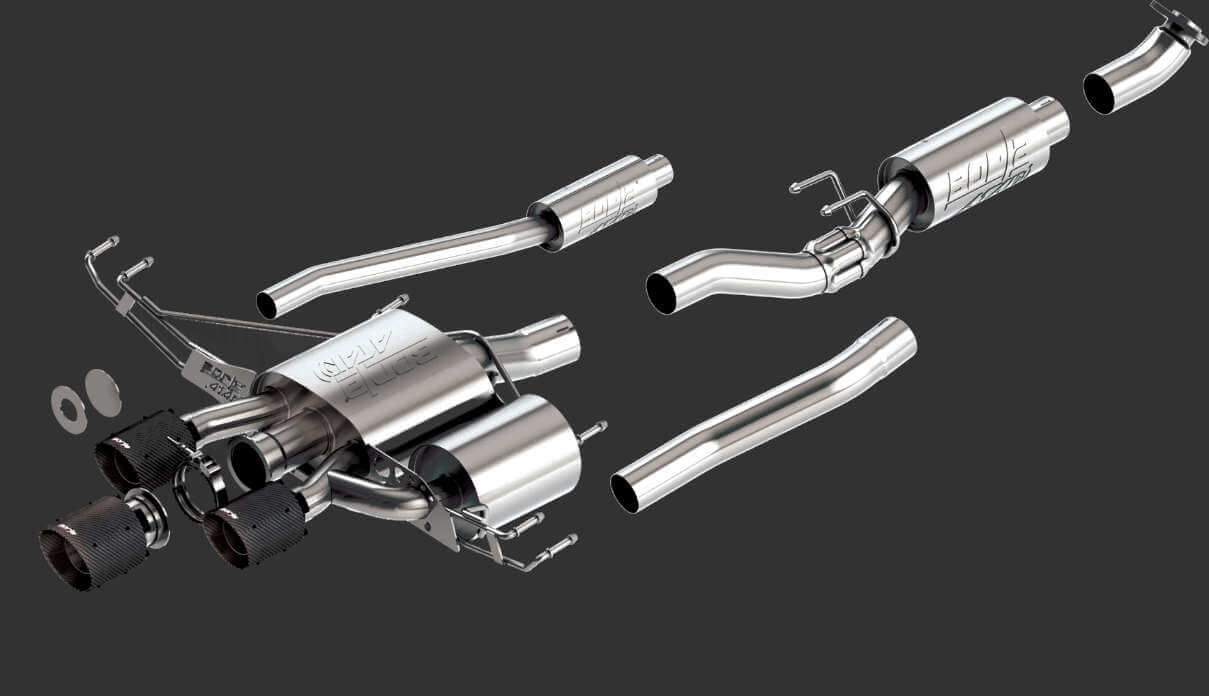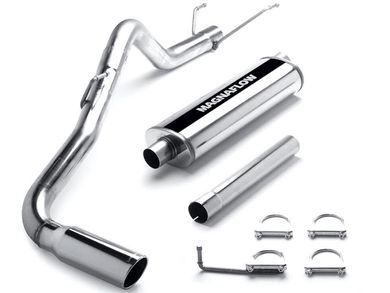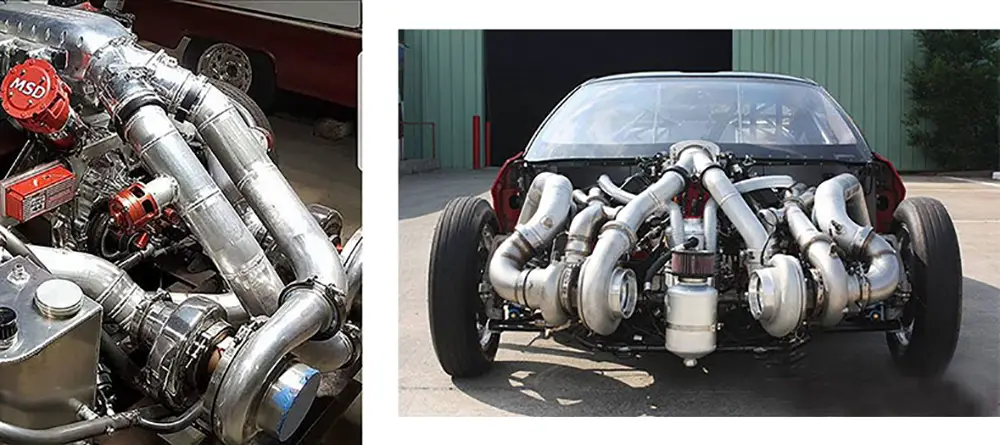Performance exhaust systems enhance vehicle power and efficiency through improved exhaust flow and engine sound. These systems are popular among car enthusiasts looking to boost performance.
Upgrading to a performance exhaust system can lead to increased horsepower and torque, as well as improved fuel efficiency. Additionally, the distinctive sound produced by these systems adds to the overall driving experience. When considering a performance exhaust systems, it’s essential to choose one that fits your vehicle model and meets your specific performance goals.
With a variety of options available on the market, selecting the right exhaust system can significantly enhance your vehicle’s performance capabilities.

Credit: www.borla.com
Contents
The Role Of Exhaust Systems In Vehicle Performance
Enhance your vehicle’s performance with high-quality performance exhaust systems. These systems optimize airflow, increasing horsepower and torque. Upgrade to a performance exhaust system for improved engine efficiency and a more exhilarating driving experience.
Exhaust Flow
The exhaust flow starts at the engine’s exhaust manifold, where the hot gases from the combustion process are collected. From there, the gases travel through the exhaust pipes, which are designed to optimize the flow and minimize restrictions. These pipes may have bends, curves, and even resonators or mufflers to control noise levels.
As the exhaust gases move through the system, they pass through the catalytic converter, which helps reduce harmful emissions. Finally, the gases exit the vehicle through the tailpipe. The efficiency of each component in the exhaust system affects the overall flow and performance of the vehicle.
Impact On Horsepower And Torque
The design and functionality of the exhaust system have a direct impact on the horsepower and torque produced by the engine. By optimizing the flow of exhaust gases, a performance exhaust system can enhance the engine’s efficiency and power output.
One of the key factors affecting performance is back pressure. Back pressure refers to the resistance encountered by the exhaust gases as they try to exit the engine. While some back pressure is necessary for efficient engine operation, excessive back pressure can hinder performance.
A performance exhaust system is designed to minimize back pressure while still maintaining the optimal level for engine function. By reducing restrictions in the exhaust system, such as using larger diameter pipes or high-flow catalytic converters, the engine can expel exhaust gases more efficiently.
Improving the exhaust flow can result in increased horsepower and torque. The engine can breathe easier, allowing for better combustion and improved power delivery. Additionally, a performance exhaust system can enhance the engine’s sound, providing a deeper and more aggressive tone.
It’s important to note that while a performance exhaust system can enhance performance, it should be paired with other modifications, such as intake upgrades or engine tuning, for maximum benefits. The overall performance gains will depend on various factors, including the vehicle’s make and model, engine specifications, and the specific components of the exhaust system.
Types Of Performance Exhaust Systems
When it comes to enhancing the performance and sound of your vehicle, choosing the right exhaust system is crucial. There are several types of performance exhaust systems available, each designed to optimize airflow and maximize engine power. Below, we’ll explore the three main types of performance exhaust systems: Cat-Back Systems, Axle-Back Systems, and Header-Back Systems.
Cat-back Systems
Cat-Back Systems replace the stock exhaust system from the catalytic converter to the rear of the vehicle. They typically include a high-flow catalytic converter, performance muffler, and larger diameter piping. The larger diameter piping reduces exhaust back pressure, resulting in improved engine efficiency and increased horsepower. Cat-Back Systems are popular among enthusiasts seeking a moderate increase in performance and a more aggressive exhaust note.
Axle-back Systems
Axle-Back Systems replace the stock exhaust system from the rear axle to the exhaust tips. While they offer a more straightforward installation compared to Cat-Back Systems, they provide a milder performance improvement.
Axle-Back Systems often feature larger, free-flowing mufflers and exhaust tips, enhancing both the visual and auditory appeal of the vehicle. They are a popular choice for those seeking a noticeable change in sound and a slight performance boost.
Header-back Systems
Header-Back Systems replace the entire exhaust system, from the exhaust headers or exhaust manifolds to the rear of the vehicle. This comprehensive upgrade allows for maximum exhaust flow, resulting in significant performance gains.
By replacing the restrictive stock headers, these systems can unleash the full potential of the engine, providing substantial horsepower and torque improvements. While installation can be more complex, the benefits of increased power and a commanding exhaust note make Header-Back Systems a top choice for performance enthusiasts.
Choosing The Right Performance Exhaust
When it comes to enhancing the performance of your vehicle, one important upgrade to consider is a performance exhaust system. Not only does it improve the overall efficiency of your engine, but it also adds a touch of style and a more exhilarating sound to your ride.
However, with so many options available, choosing the right performance exhaust can be a daunting task. In this article, we will discuss the key factors to consider when selecting the perfect performance exhaust system for your vehicle.
Material Considerations
The material used in the construction of a performance exhaust system plays a crucial role in its durability and performance. Different materials offer varying benefits, so it’s important to choose one that suits your needs. Here are some common materials used:
- Stainless Steel: This is a popular choice due to its corrosion resistance and longevity. It provides a sleek appearance and can withstand extreme temperatures.
- Titanium: Known for its lightweight properties, titanium exhaust systems offer improved power and fuel efficiency. They are also highly resistant to corrosion.
- Carbon Fiber: If you’re looking for a performance exhaust system that combines strength and weight reduction, carbon fiber is an excellent option. It provides a unique aesthetic appeal and enhances the overall performance of your vehicle.
Sound And Aesthetics
One of the most appealing aspects of a performance exhaust system is the enhanced sound it produces. The exhaust note can vary depending on the design and configuration of the system. Some enthusiasts prefer a deep and aggressive rumble, while others opt for a smoother and more refined tone.
Additionally, the aesthetics of the exhaust system can greatly impact the overall look of your vehicle. Whether you prefer a stealthy black finish or a polished chrome appearance, choose a performance exhaust that aligns with your desired sound and aesthetic preferences.
Compatibility And Installation
Before purchasing a performance exhaust system, it’s important to ensure compatibility with your specific vehicle make and model. Each exhaust system is designed to fit certain vehicles, so double-checking the compatibility is essential to avoid any installation issues.
Additionally, consider the ease of installation. Some systems may require professional installation, while others are designed for easy DIY installation. It’s crucial to select a performance exhaust system that suits your level of expertise and available resources.
By carefully considering the material, sound and aesthetics, as well as compatibility and installation requirements, you can confidently choose the right performance exhaust system for your vehicle. Remember, a well-selected performance exhaust system not only enhances the performance of your vehicle but also adds a touch of style and excitement to your driving experience.

Credit: realtruck.com
Frequently Asked Questions
Here are some FAQs about performance exhaust system –
What Exhaust System Increases Horsepower?
An exhaust system that increases horsepower typically includes larger pipes, high-flow catalytic converters, and performance mufflers. These components allow for better airflow, reducing backpressure and increasing engine power. Upgrading to a performance exhaust system can result in a noticeable improvement in horsepower and torque.
What Type Of Exhaust Is Best For Performance?
The best type of exhaust for performance is a cat-back exhaust system. It provides more power and better sound without sacrificing fuel efficiency. A cat-back exhaust system replaces the stock exhaust from the catalytic converter back to the muffler. It allows for better flow and reduces back pressure, resulting in improved horsepower and torque.
Is A Performance Muffler Worth It?
Yes, a performance muffler can improve exhaust flow and enhance engine sound. It can also slightly boost horsepower and torque.
How Much Does A Performance Exhaust System Cost?
The cost of a performance exhaust system varies based on the brand, materials, and vehicle type. On average, prices range from $300 to $2000 for parts and installation. Factors such as additional features and customization can also impact the overall cost.
Conclusion
Upgrading to a performance exhaust systems can significantly enhance your vehicle’s power and efficiency. With a range of options available, finding the right system for your car is crucial. By understanding the benefits and considerations, you can make an informed decision to improve your driving experience.
